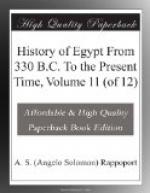Fostat was then surrounded by fortifications, and Amr took up his residence there, forming various establishments and giving himself up entirely to the organisation of the vast province whose government the caliph had entrusted to him. The personal tax, which was the only one, had been determined in a fixed manner by the treaty of submission he had concluded with the Kopts; and an unimportant ground rent on landed property was added in favour of the holy towns of Mecca and Medina, as well as to defray some expenses of local administration.
[Illustration: 329.jpg OLD CAIRO (FOSTAT)]
Egypt was entirely divided into provincial districts, all of which had their own governor and administrators taken from among the Kopts themselves. The lands which had belonged to the imperial government of Constantinople, and those of the Greeks who had abandoned Egypt or been killed in the war against the Mussulmans, were either declared to be the property of the new government or given out again as fiefs or rewards to the chief officers of the army. All these lands were leased to the Koptic farmers, and the respective rights of the new proprietors or tenant farmers and of the peasant proprietors were determined by decisive and invariable rules. Thus the agricultural population enjoyed under the Mussulmans a security and ease which replaced the tyrannical annoyances and arbitrary exactions of the Christian agents of the treasury of Constantinople; for, in fact, little by little, there had disappeared under these Greek agents the sound principles of the old administration that had been established by the wise kings of ancient Egypt, and which the Ptolemies had scrupulously preserved, as did also the first governors under the Caesars.
After all these improvements in the internal administration, the governor turned his attention to the question of justice, which until that moment had been subject to the decision of financial agents, or of the soldiers of the Greek government. Amr now created permanent and regular tribunals composed of honourable, independent, and enlightened men, who enjoyed public respect and esteem. To Amr dates back the first of those divans, chosen from the elite of the population, as sureties of the fairness of the cadis, which received appeals from first judgments to confirm them, or, in the case of wrongful decisions, to alter them. The decrees of the Arab judges had force only for those Mussulmans who formed a part of the occupying army. Whenever a Koptic inhabitant was a party in an action, the Koptic authorities had the right to intervene, and the parties were judged by their equals in race and religion.




